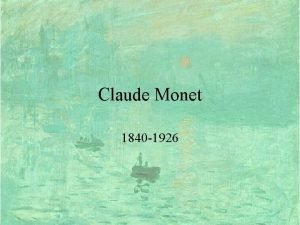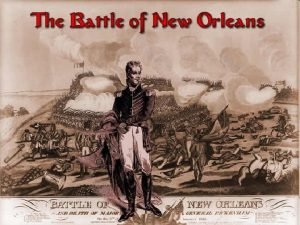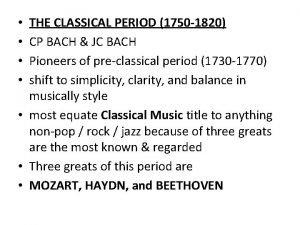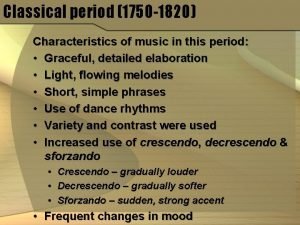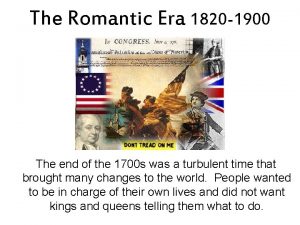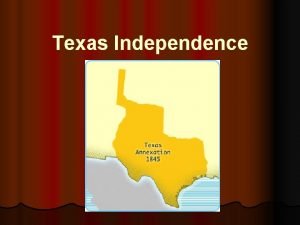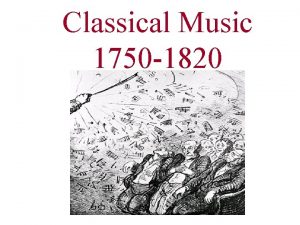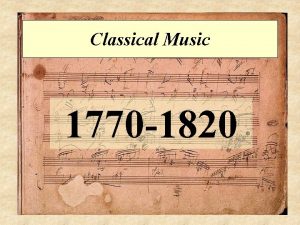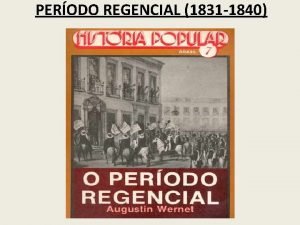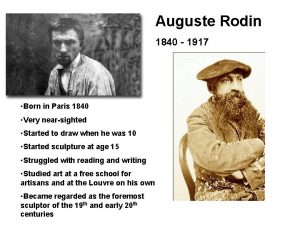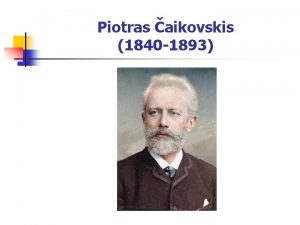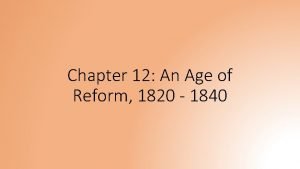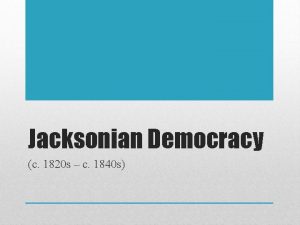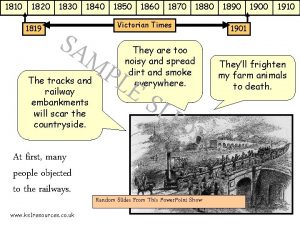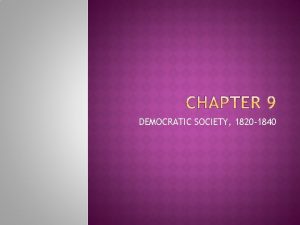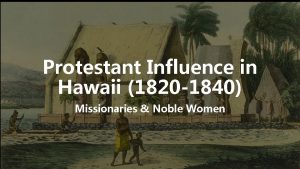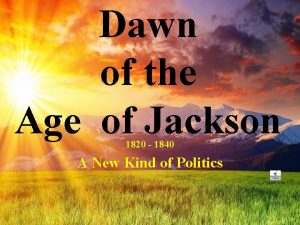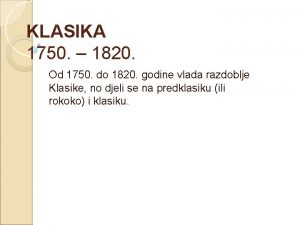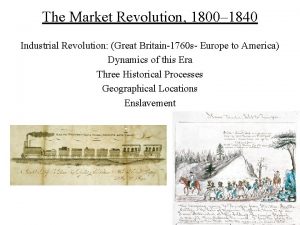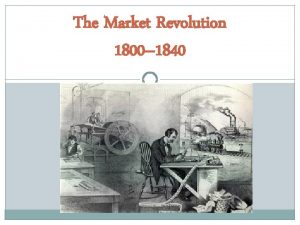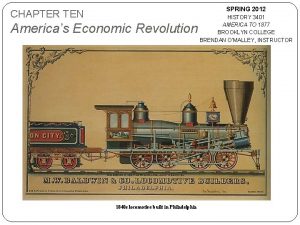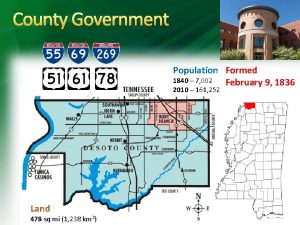ECONOMIC REVOLUTION Economic Revolution n Population 1820 1840
























- Slides: 24

ECONOMIC REVOLUTION

Economic Revolution n Population – 1820 - 1840 – cities increased, immigration highest in NE, river cities boom – Nation’s mortality rates drop n Immigration – Between 1840 - 1860, Southern Irish and Germans are highest in numbers – Irish potato famine – Often stay in ethnic divided neighborhoods-ghettos n Nativism – Immigration causes resentment and stereotyping/prejudices – ‘Low paying’ jobs, drinking, religion, even body cleanliness…. – Native American party, become Know Nothing party…Know Nothings become American party (popular in big cities) hated Irish most of all (Irish need not apply)


Transportation & Communication n By 1820 s – rivers and steamboats become crucial to n n n trade Canals become popular, Erie – West and East markets opened By 1840 s – railroads primary shipping methods *** majority in North Telegraph – Morse, 1844 City newspapers – 1846, most from North, cause rift between South Pony Express provided mail service from Missouri to California

Commerce Expansion of business in cities for consumer goods n Corporations and shareholders gained popularity n Insufficient credit – state banks issue bank notes = bank failures n Factories – by 1820 s, mostly NE n – Insufficient labor force n Technology – interchangeable parts, division of labor, machinery – Coal replaced water energy – Goodyear perfected vulcanized rubber – Mass production of iron from Ohio and Pennsylvania n Most factories owned by stockholders, not one individual

Commerce Farming – ample land, workers, shipping n Lowell mill girls – ‘proper’ environment for young ladies, behaviors emphasized n – Most women had little options for work – Working and pay conditions good, then turned very poor – Eventually replaced by immigrants n Immigrants – Irish – unskilled labor, hard labor, low pay – Factories – deskilling, lower prices, high artisan competition • • Trade unions – workers join forces to support Long hours, child labor laws non-existent Commonwealth vs. Hunt – unions are lawful organizations So many immigrants, “natives’” are often replaced Incomes steadily increase n Wealth stays in cities, but so do most of poor - lots of social mobility – ‘rags to riches’ n Many leave cities to go looking for land n

Cult of Domesticity n n n n Social roles and rules of women set ‘in stone’ Republican motherhood Arranged marriages going away –more based upon love and companionship Mostly consumers – concentrate on home ‘Working class’ women usually go to factories on domestic servant positions Female Education still very limited in opportunities Home is seen as haven for families – maintained by women

Cult of Domesticity n Middle Classes – growing – – – n Most women stay at home Diets improve, iceboxes, food transportation Indoor plumbing by 1850 Family- women centered / women provide morality to men Falling birth rates – birth control and abortions on the rise Northern agriculture – Starts to move west – Dairy, northern farming – mostly food production – Chicago, Louisville, Cincinnati – meat packing, transportation, river determines population – J. Deere – steel plows – Mc. Cormick – automatic reaper

ANTEBELLUM SOUTH

Antebellum South Upper South and Piedmont – tobacco n Florida and Texas – sugar cane n South Carolina, Georgia, Florida – rice n Short staple cotton – by 1850 s, cotton becomes main part of economy n – Lower South, cotton is King – ½ of all exports leaving US is cotton, but most valuable to US was corn from South n n n Limited transportation – relied on rivers Cotton depleted the land of nutrients, many farmers had only one crop Slaveless families and ‘po white trash’ even outranked the slave population Climate, South’s land price led to limited development of land Cavalier image of Southerners/ chivalry


Antebellum South n n n One slave sold at auction was roughly the cost back then as to a moderate car today Most families owned no slaves, most of slave owners were in South Carolina and Georgia – ¼ owned slaves By 1850 s, the South owed the North 300 million, and northern factories depended on the southern cotton to make goods Planter classes become ‘royalty’ of South – ‘honor’ and defending that honor Southern ladies – love, honor, and obey husband Plain folk – – Most Southerners were yeoman farmers – sustenance Education inferior to North Farmers relied on plantation population for supplies, credit, farming equipment Poor whites – clay eaters and crackers (1/2 a million total)


Slavery n n n Laws, slave codes and of course auctions Sizeable numbers of city slaves in South – many purchased their freedom, but by mid 19 th cent, they were seen as threat to institution, so it virtually disappeared Slave cultures thrived on large plantations – overseers Slaves divided into tasks – house slaves usually hated or taunted by other farm slaves Black women often single mothers – 2 identities, sexual target and ‘mammy’ Free blacks influenced slaves in cities – Segregation – 250, 000 in South, but poor

The Result of multiple whippings

Slavery ‘Necessary evil’ idea n Slave revolts rare n – 1831 – Nat Turner – 60 whites killed, including children --caused stricter codes and less ‘freeing’ of slaves in general n Underground Railroad – 75, 000 freed – Tubman served in Union army during Civil war – was buried with full military honors n n Run away slaves high Pidgin language develops, art, music, religion (Christianity with voodoo) Families often split up – leads to matriarchal culture, still resonates today By 1836, Southern members of the House of Representatives had made talk of slavery forbidden – “gag

Antebellum Culture n American Democratic Spirit is HIGH! n Literature – celebrated democratic principles n W. Irving, Fenimore Cooper, Walt Whitman, Herman Melville, Edgar Allen Poe n ***Art – Hudson River school

Antebellum Culture n ***Religion – Transcendentalists – individuals had reason and understanding – Ralph Emerson and Henry David Thoreau civil disobedience called for when unjust laws present – Utopian Societies • • Nashoba – communal living for freed slaves Oneida community – sexual freedom from men Shakers – completely celibate Unitarians – all were saved – good works =salvation – Mormons – Joseph Smith • Brigham Young – to Salt Lake • Belief in human perfectibility, polygamy, family most important

Revivalism By 1830 s – temperance, education, poverty, mentally ill are all just causes and crusades for middle Christian class n Every individual capable of salvation n Alcohol blamed for crime, poverty, rape, family drama – alcoholism very high n 1826 – American Society for Promotion of Temperance n – tried to make alcohol illegal – arrival of many immigrants contributed to fear of ‘the drink’ n Strongly opposed by immigrant population

Antebellum Culture n Medicine – Phrenology – E. Jenner – small pox vaccine n Education – By 1830 s, public education was wanted by most states – Horace Mann – saw education as only way to protect democracy – Blacks exempted from education – By 1850 s – taxes paid for schools in all states – Assimilation of Indians – Benevolent Empire – to help handicapped – Social values stressed, especially for girls

Antebellum Culture n Rehabilitation – strict but compassionate theory – For criminals and mentally ill – Dorthea Dix – fought for mentally ill and challenged rights – Penitentiaries were overcrowded and unhealthy n Indians – By 1850 s, reservations proposed to protect whites and Indians – Stressed assimilation n Feminism – 1830 s – Grimke sisters (abolitionists too) – C. Beecher, L. Mott, E C Stanton – Seneca Falls – 1848 • Declaration of Sentiments – right to vote • Supported by Quakers • Lucretia Mott and Sojourner Truth

Abolition 1817 – American Colonization Society – wanted the gradual freeing of slaves n By 1850, 200, 000 freed slaves living in North and West – still segregated n Colonization – wanted slaves returned to Africa – most popular in early abolition movements/ Liberia established n Sojourner Truth – “Ain’t I a Woman? ” n Frederick Douglas – n – Anti-slavery paper – North Star – Looked to politics to fix the slavery problem

Abolition n William Lloyd Garrison – The Liberator – “an abomination in the sight of God” – Think of the slaves, not the white landowners and the economy – IMMEDIATE emancipation is necessary – American anti-slavery society – Probably the most radical of his day Anti-abolition – opposition from both North and South n Abolitionists never went to Congress – not until mid 1800 s n Anti-slavery n – Free soil party – keep slavery and blacks out of federal territories – Uncle Tom’s Cabin – Harriet Beecher Stowe – response to

n
 Voto censitário
Voto censitário Fue descubierto y nombrado por schoenbein en 1840
Fue descubierto y nombrado por schoenbein en 1840 Lush j in currie v. misa
Lush j in currie v. misa Claude monet snídaně v trávě
Claude monet snídaně v trávě Liebig 1840
Liebig 1840 1814 took a little trip
1814 took a little trip Segundo reinado 1840 a 1889
Segundo reinado 1840 a 1889 Population ecology section 1 population dynamics answer key
Population ecology section 1 population dynamics answer key Population ecology section 1 population dynamics
Population ecology section 1 population dynamics Chapter 4 section 1 population dynamics study guide answers
Chapter 4 section 1 population dynamics study guide answers Chapter test a chapter 4 population ecology answer key
Chapter test a chapter 4 population ecology answer key Bach classical period
Bach classical period Militarisml
Militarisml Classical period characteristics
Classical period characteristics 1820 hairstyles
1820 hairstyles 1770s music
1770s music Moses austin
Moses austin Classical period 1750 to 1820 romantic period
Classical period 1750 to 1820 romantic period Mapa conceptual de el pensamiento social de los insurgentes
Mapa conceptual de el pensamiento social de los insurgentes La campaña definitiva 1820 a 1822
La campaña definitiva 1820 a 1822 Music of classical period 1750 to 1820
Music of classical period 1750 to 1820 It is an era from 1750-1820
It is an era from 1750-1820 1820-1750
1820-1750 Arthur and lewis tappan apush
Arthur and lewis tappan apush Juan jose flores
Juan jose flores



